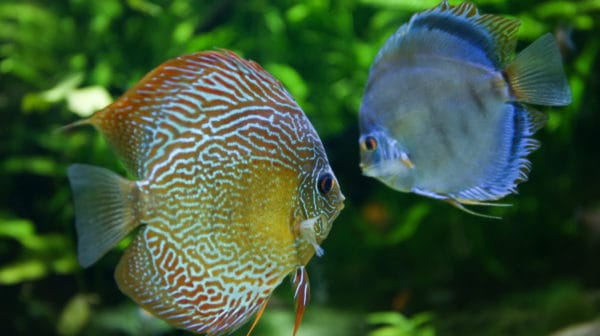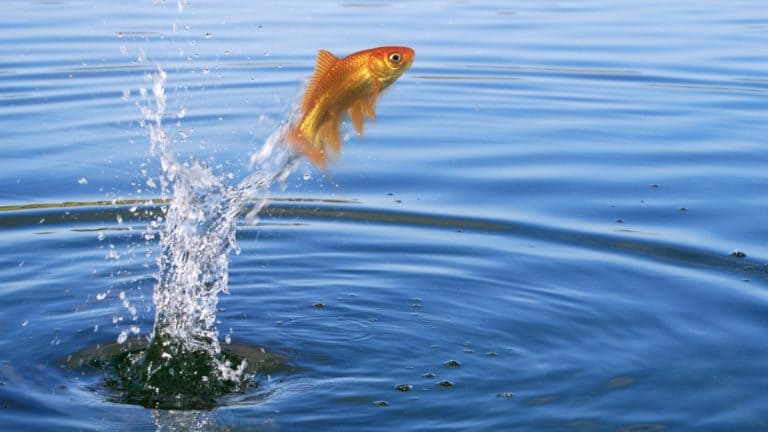Social fish may not hold territories but they do jockey for position in the group, and a certain amount of chasing and aggressive display is normal. But if the group is sufficiently large and contains a good balance of males and females, schooling fish shouldn’t cause one another serious harm.
Cichlid fish are the classic examples of territorial fish. Territories may be used to control access to food, to impress females, or as safe places to rear young. Problems occur when there isn’t enough space for both territory holders and the other fish in the community. Unable to leave the aggressive fish’s territory, the other fish end up being harassed, damaged, even killed.
Identifying Aggressive Behavior
The aquarist must recognize early signs of aggression so problems can be nipped in the bud. Typically the aggressor opens with a display such as flaring his fins or gill covers.
Threat displays are meant to give the interloper a moment to decide whether to stay and fight or swim away to safety. But in a freshwater fish aquarium, space may be so limited that the interloper cannot leave the aggressor’s territory. The aggressor responds to this as if challenged, and begins chasing or attacking the interloper. If the aggressor is the stronger tropical fish, the interloper will often end up hiding at the top of the fish aquarium or behind the filter, as far away from the aggressor as it can get, breathing heavily, and displaying muted or dark colors (often resembling those of juvenile or female fish).
If the aquarist doesn’t fix things, the weaker fish is likely to end up damaged. Torn fins are common, as is damage to the mouth and eyes. Secondary infections can quickly set in, so it’s a good idea to preemptively treat with an antibiotic to avoid problems such as fin rot and popeye. Stress can also weaken the fish’s immune system and cause it to stop eating fish food.
Schooling Fish
Aggression problems within schools can be fixed by adding further specimens. In the case of tiger barbs for example, fin-nipping amongst themselves and toward other tropical fish in the freshwater aquarium are most common when they’re kept in groups smaller than 10.
Sex ratios are important too, and among species like mollies where aggression between males is common, it’s important to have at least twice as many females than males.
In extreme cases, if a schooling species isn’t kept in adequate numbers, the dominant fish ends up harassing or killing all its companions; piranhas are notorious for this, but it can happen with tropical fish such as discus fish and Chromis too.
Introducing new fish
Schooling fish are best introduced as a group, or a succession of reasonably large groups of similar-sized individuals when new fish aquariums are being stocked. So an aquarist might add half a dozen tetras immediately after the fish aquarium has been cycled, and then another half dozen of the same species a couple of weeks later.
Territorial fish are best added to communities last of all. In fish aquariums where the tropical fish are all territorial, but some more aggressive than others, the least aggressive should be added first, the more aggressive species a few weeks later, and then the most aggressive a few weeks after them. This will give each batch of fish a chance to claim a territory.
Rearing Fish Together
Aquarists wanting a mated pair of aggressive tropical fish like cichlid fish may find it difficult to introduce two sexually mature adults to one another. The best approach with such fish is to rear a group of them together (typically six or more) and then let them pair off naturally. It should be obvious which fish are a pair, and the rest can be removed and housed elsewhere.
Removing the Aggressor
Giving an aggressive tropical fish a ‘time out’ can sometimes work, especially if the rock work, aquatic plants or fish tank decorations in the fish aquarium are rearranged. The aggressor is placed in a covered bucket for a half hour or so, and then returned to the rearranged fish aquarium, the hope being that it’ll think it’s in a new part of the river, lake or sea. It won’t stop being territorial of course, but it may define new territorial boundaries, and with luck, it’ll accept the fish already in the aquarium as part of the scenery rather than trespassers.
Removing Weaker Fish
Obviously removing a weaker fish is a good idea if it is being bullied, but what often happens is that the aggressor fish now starts picking on whichever is the weakest fish among those that remain. Think about why the aggressor is causing trouble. It may be that adding more tropical fish, rather than removing fish, will make things better.
Overstocking
If the stocking density is so high no single fish can claim a stable territory, aggression tends to subside. This is the classic solution to aggression among mbuna cichlid fish, but it also works well with fish such as mudskippers, damselfish and Ameca splendens. The problem is that overstocking massively increases the amount of filtration and maintenance work required for good water quality.
Prevention
Readers will have noticed that these solutions and workarounds don’t come with guarantees! In truth, fixing aggression problems in improperly stocked fish aquariums is actually very difficult. This is why proper research is so important. Good aquarium books will usually give some indication of the social behavior and space requirements of each species.
Posted By: Chewy Editorial
Feature Image: Africa Studio/Shutterstock.com
Share:









